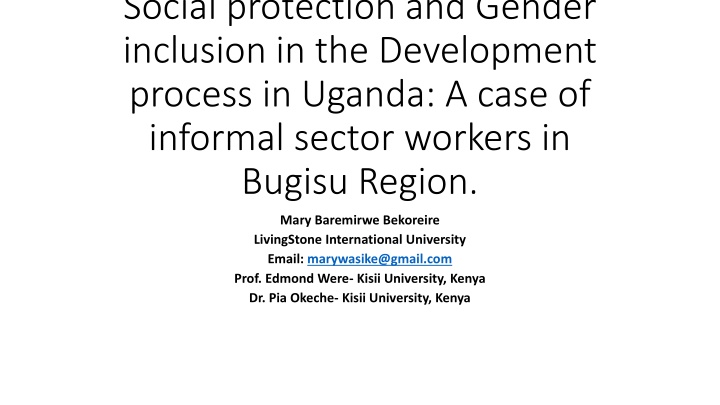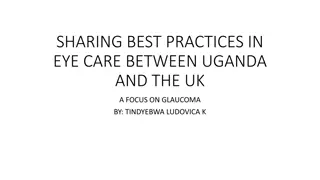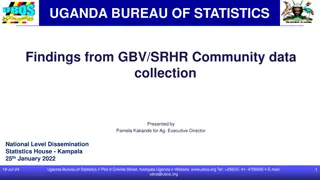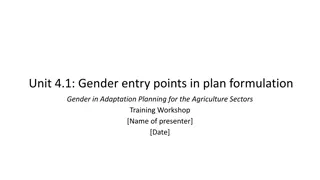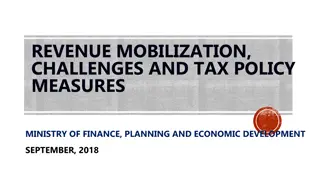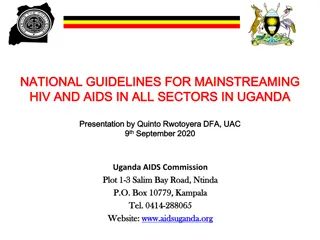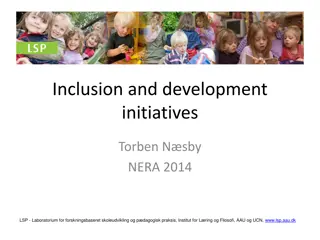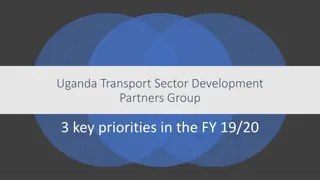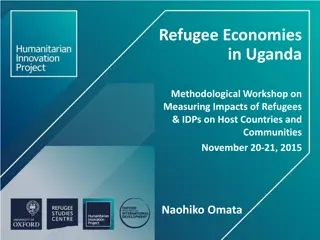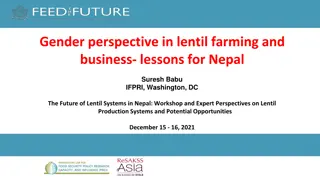Gender Inclusion in Uganda's Social Protection Policy
Social protection plays a vital role in poverty reduction by addressing risks faced by informal sector workers in Bugisu Region, Uganda. This study examines the effectiveness of Uganda's social protection policy in promoting gender inclusion.
Download Presentation

Please find below an Image/Link to download the presentation.
The content on the website is provided AS IS for your information and personal use only. It may not be sold, licensed, or shared on other websites without obtaining consent from the author.If you encounter any issues during the download, it is possible that the publisher has removed the file from their server.
You are allowed to download the files provided on this website for personal or commercial use, subject to the condition that they are used lawfully. All files are the property of their respective owners.
The content on the website is provided AS IS for your information and personal use only. It may not be sold, licensed, or shared on other websites without obtaining consent from the author.
E N D
Presentation Transcript
Social protection and Gender inclusion in the Development process in Uganda: A case of informal sector workers in Bugisu Region. Mary Baremirwe Bekoreire LivingStone International University Email: marywasike@gmail.com Prof. Edmond Were- Kisii University, Kenya Dr. Pia Okeche- Kisii University, Kenya
( ). Introduction Social protection-Process of overcoming risks and vuulnerabilities of life e.g death, unemployment, disability Social protection is one of the global social economic develpment strategies((Lwanga-Ntale, Namuddu and Onapa, 2008; Barrientos & Hulme, 2009). Hence social protection is poverty reduction strategy ( Conway,2002; Ntale et al., 2008) Informal sector workers workers with no legal contracts Increased access to social protection leads to increased service delivery Informal sector workers operate under precarious conditions statistics of informal sector workers globally=50 % of working population; 65% in sub-Saharan Africa; 93 percent in Uganda (majority are women) (Barya,2014)
Contn Most Social protection strategies are gender blind that is they are characterized by gender exclusion and inability to address specific risks of workers in the sector Majority of those excluded are women (ILO, 2012) Despite their contribution towards economic growth, there is no specific social policy that address the specific risks of workers in Uganda(Republic of Uganda, 2016) Significant development cant be realised when a significant fraction of the population is excluded in the development process Access to descent jobs, better services and skills training, enable the poor to get out of poverty and gain access to personal income (UNRSD, 2010) The paper examines the effectiveness of Uganda s social protection policy in promoting gender inclusion in the development process.
Methods Study was conducted in Bugisu Region (Mbale ,Manafwa and Namisindwa). 413 Participants [informal sector works in registered CBOs =400; NGOs= 6, MoGLSD and MoF=6) Mixed Methods design with Quantitative and Qualitative approaches Sampling methods Purposive for NGO and government participants and multi-stage and systematic sampling for inform sector workers. Only groups of informal sector workers with savings and development and legal status by December Data collection methods included FGDs and Questionnaires (informal sector workers; interviews for NGOs and government participants) Data analysis ; Descriptive for quantitative, content analysis for qualitative data
Findings Majority respondents (47.0 %) compared to 106 (30.3) who disagreed, do not perceive that there are some levels of disparities in accessing social protection on the basis of gender. Interviews confirm that there are government programs such as UWEP, YLF and SCG but specific risks of workers are not prioritised. Women and youth confirmed during FGD that none of them had membership to a formal social protection scheme. Social protection policy has not prioritized specific risks of informal sector workers Findings suggest that the development of social protection should precede needs assessment.
Item SD D NS A SA F F % F % F % F % F % F % The social protection policy in Uganda does not exclude majority women from accessing social insurance in equal measure as compared to men 17 4.9 89 25.4 83 23.7 104 29.7 57 16.3 350 100 My specific insurance needs are prioritized by the existing social protection strategies 81 23.1 97 27.7 84 24.0 74 21.1 14 4.0 350 100 Organization of workers into registered organization increases opportunity for women to access social insurance services 64 18.3 66 18.9 50 14.3 121 34.6 49 14.0 350 100 Organization of workers into registered organizations has potential to enable the government prioritize the social insurance needs in my work industry 16 4.6 26 7.4 48 13.7 200 57.1 60 17.1 350 100 The implementation of social protection strategies in Uganda empowers the low income earners to overcome risks that lead to poverty 114 32.6 129 36.9 21 6.0 66 18.9 20 5.7 350 100 Source, primary data, December, 2018
Findings 50 .7% agreed that the government has not prioritized social protection needs of informal sector workers Representation during the amendment of NSSF policy to include informal sector workers was limited to KACITA (Interview particiants). Common risks=fire outbreak, theft, loss of income, lack of market vs old age benefits and health insurance The existing empowerment programmes are not aimed at enhancing social protection: There are a number of government empowerment programmes that benefit the informal sector workers although they do not directly target them as social protection strategies. Examples are the YLF, Northern Uganda Asocial Action Fund (NUSAF) and saving schemes (Director of social protection).
Results 47.0 % agreed and 30.3 disagreed that there are no disparities in accessing social protection basing on gender. However, women are mostly engaged in unpaid work and agriculture production with irregular incomes. No attention to specific risk of women in the lifecycle (ill health, HIV/AIDS, loss of assets due to unfavorable weather and maternal related risks.
Findings (Continuation) Need to categories workers according to sectors SCG only covers 100 people in a sub county. Not all the elderly are beneficiaries. Lack of conceptual understanding of the concept of social protection by informal sector workers and how to access related services majority (49.9) agreed that organizing workers into registered organization indeed increases opportunity for women to access social insurance services compared to 37.2 % who disagreed ( the rest were not sure) However, Low incomes leads to inability of workers to contribute towards social protection schemes (average savings 1000-2000 per month)
Conclusion The social protection policy in Uganda is not conscious of gender issues that impede the social economic development of the informal sector workers. Absence of formal schemes for informal sector workers. Vulnerable groups that include women and youth, are prioritized by the empowerment programmes. However, other structural and systematic factors that limit majority the informal sector from accessing social protection schemes have not been addressed A small fraction of the elderly and youth are benefiting from the Senior Citizen s grant any Youth Livelihood Fund respectively, implying that majority are also excluded.
Recommendations Engender social service delivery in order for the government to narrow exclusion gaps. Gender and poverty vulnerability analysis should also inform the design of social protection policies to minimize on exclusion of certain groups of workers by giving special attention to risks across sectors with focus on factors such as age, gender among others. Needs assessment should precede formulation of social protection strategy for informal sector (within and across sectors)
Recommendations (Continuation) Needs assessment should precede formulation of social protection strategy for informal sector
